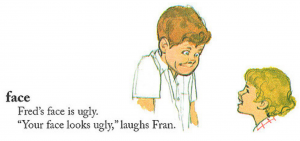Nothing like a good makeup exam
Being wrong is costly. If I think you’re aggressive when you’re not, I will behave inappropriately around you and incur costs I need not face. If I think you can help me when you can’t, I will hinder achieving my goals and give up on my search to find valuable assistance. Nevertheless, people are wrong constantly. Being wrong itself isn’t that unusual, as it takes the proper cognitive faculties, time, and energy to be right. The world is just a messy place, and there are opportunity costs to gathering, scrutinizing, and processing information, as well as diminishing returns on that search. Being wrong is costly, but so is being right, and those costs need to be balanced against each other, given limited resources. What is unusual is when people are systematically wrong about something; when they’re wrong in the same particular direction. If, say, 90% of people believe something incorrectly in the same way, that’s certainly a strange state of affairs that requires special kinds of explanations.
As such, if you believe people are systematically wrong about something, there are two things you should probably do: (1) earnestly assess whether your belief about them being wrong is accurate – since it’s often more likely you’re wrong than everyone else is – and then, if they actually are wrong, (2) try to furnish the proper explanation for that state of affairs and test it.
Putting that in an example I’ve discussed before, some literature claims that men over-perceive women’s sexual interest (here). In other words, the belief here is that many men are systematically wrong in the same way; they’re making the same error. One special explanation provided for this was that men over-perceiving sexual interest would lead them to approach more women (they otherwise wouldn’t) and ultimately get more mating opportunities as a result. So men are wrong because being wrong brings more benefits than costs. There are some complications with that explanation, however. First, why would we expect men to not perceive women’s interests more accurately (she’s not interested in me) but approach them anyway (the odds are low, but I might as well go for it)? That would lead to the same end point (approaching lots of women) without the inaccuracy that might have other consequences (like failing to pursue a woman who’s actually interested because you mistakenly believe a different woman is interested when she isn’t). The special explanation also falls apart when you consider that when you ask women about other women’s sexual interest, you get the same result as the men. So either men and women are over-perceiving women’s sexual interest, or perhaps they aren’t wrong. Perhaps individual women are under-reporting their own interest for some social reasons. Maybe the women’s self-reports are inaccurate (consciously or not), rather than everyone else being wrong about them. The explanation that one person is wrong, rather than everyone else is, feels more plausible.
Speaking of women’s sexual interest and people being wrong, let’s talk about a new paper touting the idea that everyone is wrong about women’s makeup usage. Specifically, lots of people seem to be using makeup usage as a cue to a woman’s short-term sexual interest, and the researchers believe they’re all wrong to do so. That makeup is an invalid cue of sociosexuality.
Aren’t they all…
This was highlighted in three studies, which I’ll cover quickly. In the first, 69 women were photographed with and without their day-to-day makeup. Raters – 182 of them – judged those pictures in terms of (1) how much makeup they felt the women were wearing, (2) how attractive the faces were, and (3) how much they felt the women pictured would be comfortable with and enjoy having casual sex with different partners; a measure of sociosexuality. The results showed that male (d = 0.64) and female (d = 0.88) raters judged women with makeup as more attractive than same women without, and also that the women wearing makeup were more comfortable with casual sex than without. For those curious, this latter difference was larger for female raters (d = 1.14) than male ones (d = 0.32). Putting that into numbers, men rated women wearing makeup as about 0.2 points more likely to enjoy casual sex on a scale from 1-9; for women, this difference was closer to 0.5 points. Further, men’s perceptions of women’s interest in casual sex seemed to be driven less by makeup per se, as much as it was driven by a woman’s perceived attractiveness (and since makeup made them look more attractive, they also looked more interested in casual sex). The primary finding here, however, is that the perception was demonstrated: people (men and women) use women’s makeup usage as a cue to their sociosexuality.
Also, men were worse at figuring out when women weren’t wearing any makeup, compared to women likely given a lack of experience with the topic. Here, being wrong isn’t surprising.
The second study asked the women wearing the makeup themselves to answer questions about their own sociosexuality (using several items, rather than a single question). They were also asked about how much time they spent applying makeup and how much they spent on it on each month. The primary result here was a reported lack of correlation between women’s scores on the sociosexuality questions and the time they spent applying makeup. In other words, people thought makeup was correlated to sexual attitudes and behaviors, but it wasn’t. People were wrong, but in predictable ways. This ought to require a special kind of explanation, and we’ll get to that soon.
The final study examined the relationship between people’s perceptions of a woman’s sociosexuality and her own self-reports of it. Both men and women again seemed to get it wrong, with negative correlations showing up between perceived and self-reported sociosexuality. Both went in a consistent direction, though only the male correlations were significant (male raters about r = -0.33; female raters r = -0.21). Once attractiveness was controlled for, however, the male correlation was similarly non-significant and comparable to women’s ratings (average r = -0.22).
The general pattern of results, descriptively, is that men and women seem to perceive women wearing makeup as being more interested in casual sex than women not wearing makeup. However, the women themselves don’t self-report being more interested in casual sex; if anything, they report being less interested in it than people perceive. Isn’t it funny how so many people are consistently and predictably wrong about this? Perhaps. Then again, I think there’s more to say about the matter which isn’t explored in much detail within the paper.
“This paper is an invalid cue of the truth”
The first criticism of this research that jumped out at me is that the researchers only recruited women who used makeup regularly to be photographed, rated, and surveyed. In that context, they report no relationship between makeup use and sociosexuality (which we’ll get to in a minute, as that’s another important matter). Restricting their sample in this way naturally reduces the variance in the population, which might make it harder to find a real relationship that actually exists. For instance, if I was curious whether height is an important factor in basketball skill, I might find different answers to this question if I surveyed the general population (which contains lots of tall and short people) than if I only surveyed professional basketball players (who all tend to be taller than average; often substantially so). To the authors’ credit, they do mention this point…in their discussion, as more of an afterthought. This suggests to me the point was raised by a reviewer and was only added to the paper after the fact, as awareness of this sampling issue would usually encourage researchers to examine the question in advance, instead of just note that they failed to do so at the end. So, if a relationship exists between makeup use and interest in casual sex, they might have missed it through selective sampling.
The second large criticism concerns the actual reported results, and by how much that finding was missed. I find it noteworthy how the researchers interpret the correlation between women’s self-reported time applying makeup and their self-reported sociosexuality. In the statistical sense, the correlation is about as close to the significant threshold as possible; r = .25, p = 0.051. As the cut-off for significance is 0.05 or lower, this is a relationship that could (and likely would) be interpreted as evidence consistent with the possibility that a link between makeup usage and sociosexuality does exist, if one was looking for a connection; that makeup use is, potentially, a valid cue of sexual interests and behaviors. Nevertheless, the authors interpret it as “not significant” and title their paper accordingly (“Makeup is a FALSE signal of sociosexuality”, emphasis mine). That’s not wrong, in the statistical sense. It also feels like a rather bold description for data that is a hair’s breadth away from reaching the opposite conclusion, and suggests to me the authors had a rather specific hypothesis going into this. Again, to their credit, the authors note there is a “trend” there, but that stands in stark contrast to their rather dramatic title and repeated claims that makeup is an invalid cue. In fact, every instance of them noting there’s a trend between makeup use and sociosexuality seems to be followed invariably by a claim that the results suggest there is no relationship.
Further, there is a point never really discussed at all, which is that women might under-report their own sociosexuality, as per the original research I mention, perhaps because they’re wary of incurring social costs from being viewed as promiscuous. In many domains, I would default to the assumption that the self-reports are somewhat inaccurate. For example, when I surveyed women about their self-perceived attractiveness (from 1-10) several years back, not a single one rated herself below a 6 (out of 10), and the average was higher than that. Either I had managed recruited a sample of particularly beautiful women (possible) or people are interested in you believing they’re better than they actually are (more likely). After all, if you believe something inaccurately about a person that’s flattering, while it may be a cost to you, it’s a benefit to them. So what’s more likely: that everyone believes something that’s wrong about others, or that some people misrepresent themselves in a flattering light?
Doesn’t get much more flattering than that
As a final note on explaining these findings, it is worth exploring the possibility that a woman’s physical attractiveness/makeup use actually is correlated with relatively higher sociosexuality (despite the author’s claims this isn’t true). In other words, people aren’t making a perceptual mistake – the general correlate holds true – but the current sample missed it for whatever reason (even if just barely). Indeed, there is some evidence that more attractive women score slightly higher on measures of sociosexuality (N = 226; Fisher et al, 2016. Ironically, this was published in the same journal 2 years prior). While short-term encounters do carry some adaptive costs for women, this small correlation might arise due to more physically-attractive women receiving offers for short-term encounters that can better offset them. At the very least, it could be expected that because attractive women carry more value in the mating market place these offers are, in principle, more numerous. Increasing numbers of better options should equal greater comfort and interest.
If that is true – that attractiveness does correlate in some small way with sociosexual orientation – then this could also help explain the (also fairly small) correlation between makeup usage and perceived sociosexuality: people view attractive women as more open to short-term encounters, makeup artificially increases attractiveness, and so people judge women wearing makeup as more open to short-term encounters than they are.
We can even go one layer deeper: women generally understand that makeup makes them look more attractive. They also understand that the more attractive they look, the more positive mating attention they’ll likely receive. Applying makeup, then, can be an effort to attract mating attention, in much the same way that I might wear a nice suit if I was going on a job interview. However, neither the suit nor the makeup is a “smart bomb”, so to speak. I might wear a suit to attract the attention of specific employers, but just because I’m wearing a suit that doesn’t mean I want any job (and if Taco Bell wanted to hire me, I might be choosy and say “No thanks”). Similarly, a woman wearing makeup might be interested in attracting mating attention from specific sources – and be perceived as being more sexually motivated, accordingly – without wishing to send a global signal of sexual interest to all available parties. That latter part just happens as a byproduct. Nevertheless, in this narrower sense, makeup usage could rightly be perceived as a sign of sexual signaling; perhaps one that ends up getting perceived a bit more broadly than intended.
Or perhaps it’s not even perceived more broadly. The question asked of raters in the study was whether a woman would be comfortable and enjoying having casual sex with different partners; it’s unspecified as to the nature of those partners. “Different” doesn’t mean “just anyone”. Women who are interested in makeup might be slightly more interested in these pursuits, on average…but only so long as the partners are suitably attractive.
References: Batresa, C., Russella, R., Simpsonb, J., Campbellc, L., Hansend, A., &
Cronke, L. (2018). Evidence that makeup is a false signal of sociosexuality. Personality & Individual Differences, 122, 148-154
Fisher, C., Hahn, A., DeBruine, L., & Jones, B. (2016). Is women’s sociosexual orientation related to their physical attractiveness? Personality & Individual Differences, 101, 396-399



































